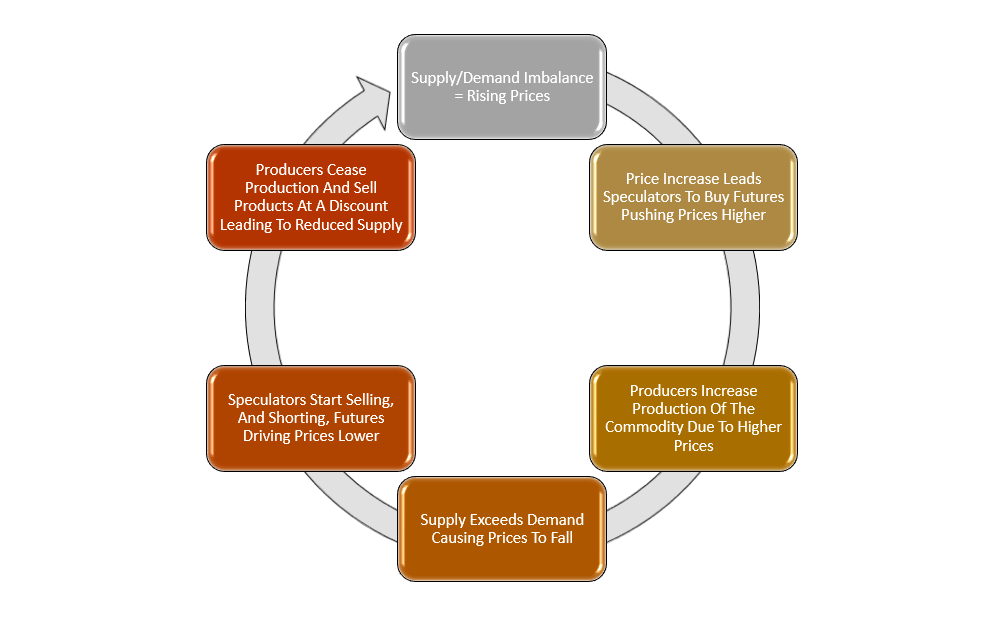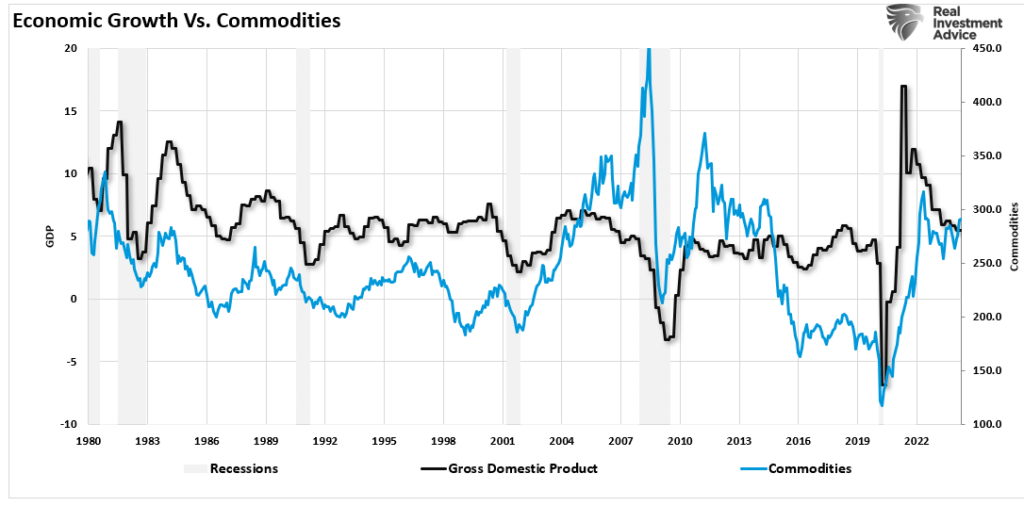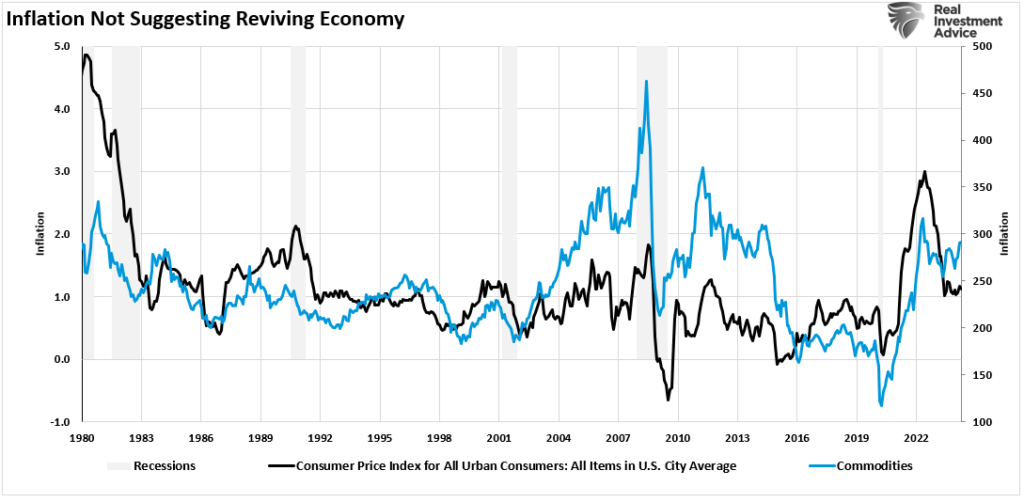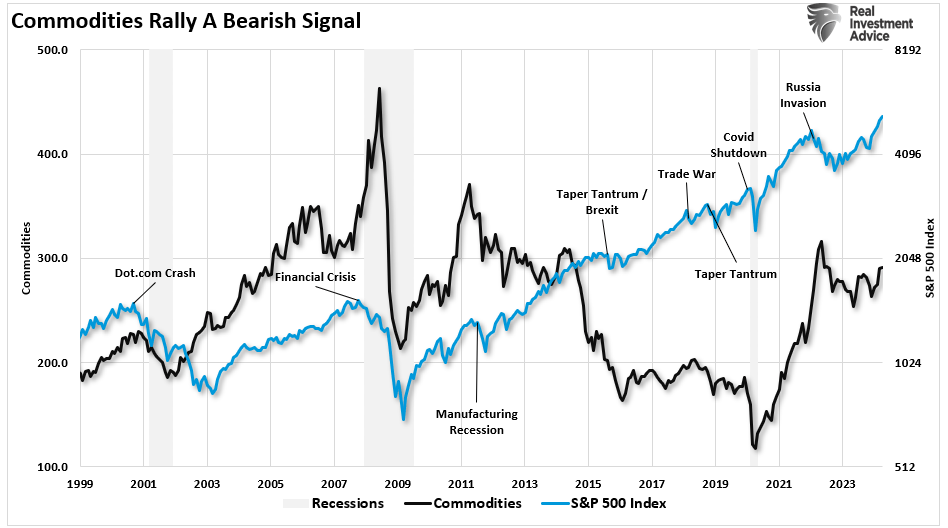It’s at all times fascinating when commodity costs rise. The market produces numerous narratives to counsel why costs will continue to grow indefinitely. Such applies to all commodities, from oil to orange juice or cocoa beans. For instance, Michael Hartnett of BofA not too long ago famous:
The 40-year interval from 1980 to 2020 was the period of disinflation: due to fiscal self-discipline, globalization, and peace, markets noticed ‘deflation belongings’ (authorities and company bonds, S&P, development shares) outperform ‘inflation belongings’ (money, commodities, TIPS, EAFE, banks, worth). As proven beneath, ‘deflation’ annualized 10% vs. 8% for ‘inflation’ over the 40-year interval.
However the regime change of the previous 4 years has roles reversed, and now ‘magnificent’ inflation belongings are annualizing 11% returns vs 7% for deflation belongings.”

Thoughts you, this isn’t the primary time that markets have gone “cuckoo for commodities.” The newest episode in 2007 was “Peak Oil.” Nevertheless, crucially, this time is rarely completely different. As proven beneath, commodities usually have surges in efficiency and are the best-performing asset class in a given yr or two. Then, that efficiency reverses sharply to the worst-performing asset class.


That efficiency “growth and bust” has remained because the Nineteen Seventies. The chart beneath exhibits the Commodities Index’s efficiency over the past 50 years. On a buy-and-hold foundation, traders obtained a 40% whole return on their funding. It is because, alongside the way in which, there have been implausible rallies in commodities adopted by enormous busts.


Such brings us to the large query? Why do commodities usually growth and bust?


Why Do Commodities Increase And Bust
The issue with the concept of a structural shift to commodities sooner or later and why it hasn’t occurred prior to now is because of the drivers of commodity costs.
Here’s a simplistic instance.
- Throughout a commodity cycle, the preliminary section of a commodity worth improve is because of rising demand exceeding current provide. That is usually seen in orange juice, the place a drought or infestation wipes out a season’s crops. Instantly, the present demand for orange juice massively outweighs the availability of oranges.
- As orange juice costs rise, Wall Road speculators begin bidding up the worth of orange juice futures contracts. As orange juice costs improve, extra speculators purchase futures contracts driving the worth of orange juice larger.
- Farmers scrap plans to supply lemons and improve the orange provide in response to larger orange juice costs. As extra oranges are produced, the availability of oranges begins to outstrip the demand for orange juice, resulting in a list glut of oranges. The surplus provide of oranges requires producers to promote them at a less expensive worth; in any other case, they are going to rot within the warehouses.
- Wall Road speculators start to promote their futures contracts as costs decline, pushing the worth decrease. As costs fall, extra speculators dump their contracts and promote quick orange futures contracts, inflicting costs to fall additional.
- With the worth of oranges crashing, farmers cease planting orange bushes and begin rising lemons once more.
- The cycle then repeats.


Moreover, excessive commodity costs threaten themselves. As at all times, “excessive costs are a remedy for prime costs.” If orange juice costs develop into too costly, customers will eat much less, resulting in declining demand and provide buildup. The next chart of commodities in comparison with nominal GDP exhibits the identical. At any time when there was a pointy rise in commodity costs, it slowed financial development charges. Such is unsurprising since consumption drives ~70% of GDP.


There’s additionally a excessive correlation between commodities and inflation. It ought to be self-evident that when commodity costs rise, the price of items and companies additionally rises as a consequence of larger enter prices. Nevertheless, the worth improve is constrained as customers are unable to buy these items and companies. As famous, the consequence of upper costs is much less demand. Much less demand results in decrease costs or disinflation.


Such is why arduous asset trades repeatedly finish badly regardless of the extra ebullient media protection.


Exhausting Asset Trades Have a tendency To Finish Badly
Commodities, and arduous belongings normally, may be an exhilarating and worthwhile journey on the way in which up. Nevertheless, as proven within the long-term chart above, that commerce tends to finish badly. Commodities have repeatedly led market downturns and recessions.


Will this time be completely different? Such is unlikely to be the case for 2 causes.
As mentioned, excessive costs (inflation) are the remedy for prime costs because it reduces demand. As proven above, as the buyer retrenches, demand will fall, resulting in decrease inflation sooner or later.
Secondly, because the nation strikes towards a extra socialistic profile, financial development will stay constrained to 2% or much less, with deflation remaining a constant long-term menace. Dr. Lacy Hunt suggests the identical.
“Contrary to traditional knowledge, disinflation is extra doubtless than accelerating inflation. Since costs deflated within the second quarter of 2020, the annual inflation charge will transfer transitorily larger. As soon as these base results are exhausted, cyclical, structural, and financial issues counsel that the inflation charge will average decrease by year-end and undershoot the Fed Reserve’s goal of two%. The inflationary psychosis that has gripped the bond market will fade away within the face of such persistent disinflation.“
As he concludes:
“The 2 major structural impediments to conventional U.S. and international financial development are large debt overhang and deteriorating demographics each having worsened as a consequence of 2020.“
The final level is essential. As liquidity drains from the system, the debt overhang weighs on consumption as incomes are diverted from productive exercise to debt service. As such, the demand for commodities will weaken.
Whereas the commodity commerce is actually “in bloom” with the surge in liquidity, watch out of its eventual reversal.
For traders, deflation stays a “entice within the making” for arduous belongings.
There’s nothing improper with proudly owning commodities; simply don’t overlook to take earnings.
Put up Views: 2,433
2024/06/07